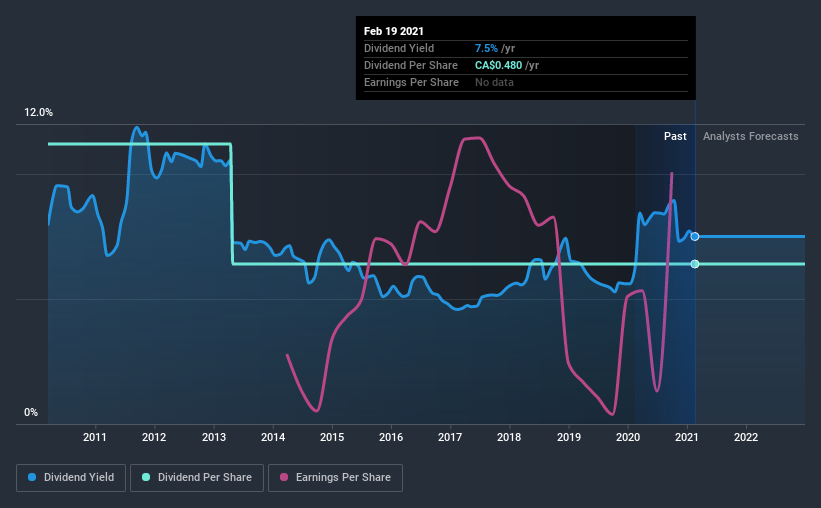Extendicare Inc. (TSE:EXE) Pays A CA$0.04 Dividend In Just Four Days
Readers hoping to buy Extendicare Inc. (TSE:EXE) for its dividend will need to make their move shortly, as the stock is about to trade ex-dividend. Ex-dividend means that investors that purchase the stock on or after the 25th of February will not receive this dividend, which will be paid on the 15th of March.
Extendicare's next dividend payment will be CA$0.04 per share, and in the last 12 months, the company paid a total of CA$0.48 per share. Based on the last year's worth of payments, Extendicare stock has a trailing yield of around 7.5% on the current share price of CA$6.4. Dividends are a major contributor to investment returns for long term holders, but only if the dividend continues to be paid. That's why we should always check whether the dividend payments appear sustainable, and if the company is growing.
See our latest analysis for Extendicare
Dividends are typically paid out of company income, so if a company pays out more than it earned, its dividend is usually at a higher risk of being cut. Extendicare paid out 128% of profit in the past year, which we think is typically not sustainable unless there are mitigating characteristics such as unusually strong cash flow or a large cash balance. That said, even highly profitable companies sometimes might not generate enough cash to pay the dividend, which is why we should always check if the dividend is covered by cash flow. Dividends consumed 71% of the company's free cash flow last year, which is within a normal range for most dividend-paying organisations.
It's good to see that while Extendicare's dividends were not covered by profits, at least they are affordable from a cash perspective. Still, if the company repeatedly paid a dividend greater than its profits, we'd be concerned. Very few companies are able to sustainably pay dividends larger than their reported earnings.
Click here to see the company's payout ratio, plus analyst estimates of its future dividends.
Have Earnings And Dividends Been Growing?
Stocks in companies that generate sustainable earnings growth often make the best dividend prospects, as it is easier to lift the dividend when earnings are rising. If business enters a downturn and the dividend is cut, the company could see its value fall precipitously. That's why it's comforting to see Extendicare's earnings have been skyrocketing, up 24% per annum for the past five years.
The main way most investors will assess a company's dividend prospects is by checking the historical rate of dividend growth. Extendicare's dividend payments per share have declined at 5.4% per year on average over the past 10 years, which is uninspiring. Extendicare is a rare case where dividends have been decreasing at the same time as earnings per share have been improving. It's unusual to see, and could point to unstable conditions in the core business, or more rarely an intensified focus on reinvesting profits.
Final Takeaway
Is Extendicare an attractive dividend stock, or better left on the shelf? Growing earnings per share and a normal cashflow payout ratio is an ok combination, but we're concerned that the company is paying out such a high percentage of its income as dividends. In summary, it's hard to get excited about Extendicare from a dividend perspective.
If you want to look further into Extendicare, it's worth knowing the risks this business faces. To that end, you should learn about the 4 warning signs we've spotted with Extendicare (including 3 which are concerning).
We wouldn't recommend just buying the first dividend stock you see, though. Here's a list of interesting dividend stocks with a greater than 2% yield and an upcoming dividend.
This article by Simply Wall St is general in nature. It does not constitute a recommendation to buy or sell any stock, and does not take account of your objectives, or your financial situation. We aim to bring you long-term focused analysis driven by fundamental data. Note that our analysis may not factor in the latest price-sensitive company announcements or qualitative material. Simply Wall St has no position in any stocks mentioned.
Have feedback on this article? Concerned about the content? Get in touch with us directly. Alternatively, email editorial-team (at) simplywallst.com.

 Yahoo Finance
Yahoo Finance 
